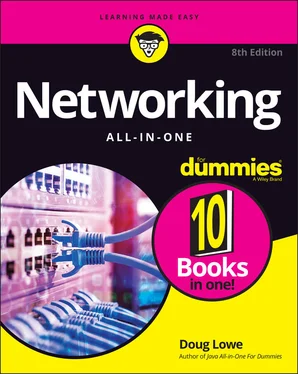A Little Internet History
The Internet has a fascinating history, if such things interest you. There’s no particular reason why you should be interested in such things, of course, except that a superficial understanding of how the Internet got started may help you to understand and cope with the way this massive computer network exists today. So here goes.
The Internet traces its beginnings back to a small network called ARPANET, built by the Department of Defense in 1969 to link defense installations. ARPANET soon expanded to include not only defense installations but universities as well. In the 1970s, ARPANET was split into two networks: one for military use (renamed MILNET) and the original ARPANET (for nonmilitary use). The two networks were connected by a networking link called IP — the Internet protocol — so called because it allowed communication between two networks.
The good folks who designed IP had the foresight to realize that soon, more than two networks would want to be connected. In fact, they left room for tens of thousands of networks to join the game, which is a good thing because it wasn’t long before the Internet began to take off.
By the mid-1980s, ARPANET was beginning to reach the limits of what it could do. Enter the National Science Foundation (NSF), which set up a nationwide network designed to provide access to huge supercomputers, those monolithic computers used to discover new prime numbers and calculate the orbits of distant galaxies. The supercomputers were never put to much use, but the network that was put together to support the supercomputers — NSFNET — was used. In fact, NSFNET replaced ARPANET as the new backbone for the Internet.
Then, out of the blue, it seemed as if the whole world became interested in the Internet. Stories about it appeared in Time and Newsweek. Any company that had “dot com” in its name practically doubled in value every month. Al Gore claimed he invented the Internet. The Net began to grow so fast that even NSFNET couldn’t keep up, so private commercial networks got into the game. The size of the Internet nearly doubled every year for most of the 1990s. Then, in the first few years of the millennium, the growth rate slowed a bit. However, the Internet still seems to be growing at the phenomenal rate of about 30 to 50 percent per year, and who knows how long this dizzying rate of growth will continue.
TCP/IP Standards and RFCs
The TCP/IP protocol standards that define how the Internet works are managed by the IETF. However, the IETF doesn’t impose standards. Instead, it simply oversees the process by which ideas are developed into agreed-upon standards.
An Internet standard is published in the Request for Comments (RFC) document. When a document is accepted for publication, it is assigned an RFC number by the IETF. The RFC is then published. After it’s published, an RFC is never changed. If a standard is enhanced, the enhancement is covered in a separate RFC.
Thousands of RFCs are available from the IETF website ( www.ietf.org ). The oldest RFC is RFC 0001, published in April 1969. It describes how the host computers communicated with each other in the original ARPANET. As of this writing, the most recent proposed standard is RFC 8892, entitled “Guidelines and Registration Procedures for Interface Types and Tunnel Types.”
Not all RFCs represent Internet standards. The following paragraphs summarize the various types of RFC documents:
Internet Standards Track: This type of RFC represents an Internet standard. Standards Track RFCs have one of three maturity levels, as described in Table 2-1. An RFC enters circulation with Proposed Standard status but may be elevated to Draft Standard status — and, ultimately, to Internet Standard status.
Experimental specifications: These are a result of research or development efforts. They’re not intended to be standards, but the information they contain may be of use to the Internet community.
Informational specifications: These simply provide general information for the Internet community.
Historic specifications: These RFCs have been superseded by a more recent RFC and are thus considered obsolete.
Best Current Practice (BCP): RFCs are documents that summarize the consensus of the Internet community’s opinion on the best way to perform an operation or procedure. BCPs are guidelines, not standards.
TABLE 2-1Maturity Levels for Internet Standards Track RFCs xxx
| Maturity Level |
Description |
| Proposed Standard |
Generally stable, have resolved known design choices, are believed to be well understood, have received significant community review, and appear to enjoy enough community interest to be considered valuable. |
| Draft Standard |
Well understood and known to be quite stable. At least two interoperable implementations must exist, developed independently from separate code bases. The specification is believed to be mature and useful. |
| Internet Standard |
Have been fully accepted by the Internet community as highly mature and useful standards. |
Table 2-2summarizes the RFCs that apply to the key Internet standards described in this book.
TABLE 2-2RFCs for Key Internet Standards
| RFC |
Date |
Description |
| 768 |
August 1980 |
User Datagram Protocol (UDP) |
| 791 |
September 1981 |
Internet Protocol (IP) |
| 792 |
September 1981 |
Internet Control Message Protocol (ICMP) |
| 793 |
September 1981 |
Transmission Control Protocol (TCP) |
| 826 |
November 1982 |
Ethernet Address Resolution Protocol (ARP) |
| 950 |
August 1985 |
Internet Standard Subnetting Procedure |
| 959 |
October 1985 |
File Transfer Protocol (FTP) |
| 1034 |
November 1987 |
Domain Names — Concepts and Facilities (DNS) |
| 1035 |
November 1987 |
Domain Names — Implementation and Specification (DNS) |
| 1939 |
May 1996 |
Post Office Protocol Version 3 (POP3) |
| 2131 |
March 1997 |
Dynamic Host Configuration Protocol (DHCP) |
| 3376 |
November 1997 |
Internet Group Management Protocol (IGMP) (Updates RFC 2236 and 1112) |
| 7230 through 7235 |
June 2014 |
Hypertext Transfer Protocol – HTTP/1.1 |
| 5321 |
October 2008 |
Simple Mail Transfer Protocol (SMTP) |
 My favorite RFC is 1149, an experimental specification for the “Transmission of IP datagrams on avian carriers.” The specification calls for IP datagrams to be written in hexadecimal on scrolls of paper and secured to “avian carriers” with duct tape. (Not surprisingly, it’s dated April 1, 1990. Similar RFCs are frequently submitted on April 1.)
My favorite RFC is 1149, an experimental specification for the “Transmission of IP datagrams on avian carriers.” The specification calls for IP datagrams to be written in hexadecimal on scrolls of paper and secured to “avian carriers” with duct tape. (Not surprisingly, it’s dated April 1, 1990. Similar RFCs are frequently submitted on April 1.)
The TCP/IP Protocol Framework
Like the seven-layer OSI Reference Model, TCP/IP protocols are based on a layered framework. TCP/IP has four layers, as shown in Figure 2-1. These layers are described in the following sections.

FIGURE 2-1:The four layers of the TCP/IP framework.
Читать дальше

 My favorite RFC is 1149, an experimental specification for the “Transmission of IP datagrams on avian carriers.” The specification calls for IP datagrams to be written in hexadecimal on scrolls of paper and secured to “avian carriers” with duct tape. (Not surprisingly, it’s dated April 1, 1990. Similar RFCs are frequently submitted on April 1.)
My favorite RFC is 1149, an experimental specification for the “Transmission of IP datagrams on avian carriers.” The specification calls for IP datagrams to be written in hexadecimal on scrolls of paper and secured to “avian carriers” with duct tape. (Not surprisingly, it’s dated April 1, 1990. Similar RFCs are frequently submitted on April 1.)











